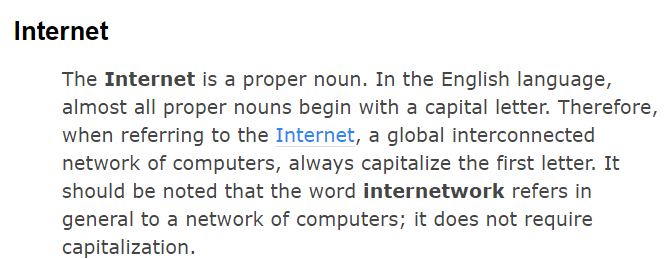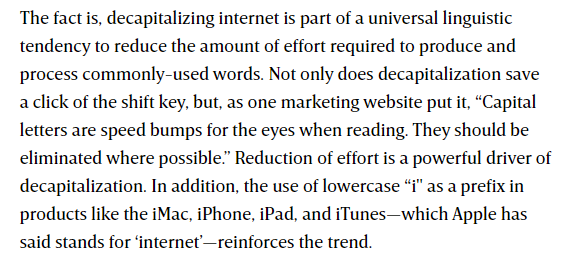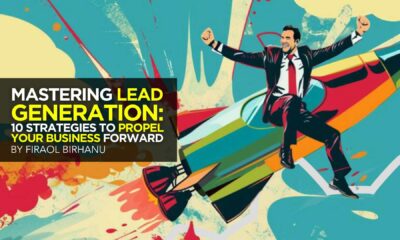MARKETING
How to Capitalize When Writing for the Web (Grammar Lessons)

You sit down to write an amazing post for your blog.
Everything feels right.
Your creative juices are flowing.
Your mind is forming sentences faster than your fingers can type them.
You feel excitement building.
And then you hit a snag.
It’s small, but it slows you down.
Should you write it “internet” or “Internet?”
Is it email or e-mail?
SERPS, SERP’s, or SERPs?
You go online to search for the answer. Spend 20 minutes reading grammar rules. When you come back to your blog post, you’ve lost your vibe.
How can you prevent this from happening?
The best way is to learn the basic capitalization rules for online writing.
You don’t want to appear sloppy and ignorant of the basic capitalization rules sophisticated bloggers use.
But you also don’t want to seem stuffy and overly traditional.
Keep these four simple capitalization rules beside you each time you sit down to write.
Lesson 1: Don’t Capitalize Terms That Have Entered Common Usage
Brand new words are usually capitalized when they’re introduced into a language.
For instance, take the word scuba.
In 1952, SCUBA was coined as an acronym for Self-Contained Underwater Breathing Apparatus.
Later, as the word became common and generic, it was changed to lowercase and became “scuba.”
Here are two examples of online words that have been changed to lowercase because of common usage.
Is It “Internet” or “internet”?
When the word “internet” first appeared, it was capitalized.
“In its generic sense, internet is a common noun, a synonym for internetwork; therefore, it has a plural form and is not capitalized. In its specific sense, it is a proper noun, and therefore, without a plural form and traditionally capitalized.” – Search Engine Journal, March 18, 2011
According to this Computer Hope, we should capitalize the specific “internet” we’re using to distinguish it from other internetworks.

However, as the word became a huge part of language and everyday life, experts began arguing that it should be lower cased.

After serious debate, style guides began adopting the popular trend.
In 2016, the AP Stylebook announced it would no longer recommend capitalizing “internet”.

On March 23, 2017, The Chicago Manual of Style followed suit.
So, while “internet” is technically a proper noun and should be capitalized, common usage and the evolution of grammar allows us to write it in lowercase letters.
Is It “Web” or “web”?
The word “web” stands for “World Wide Web.”
Like “internet,” it was capitalized when it first appeared in the English language.
However, it was changed to lowercase at the same time as “internet.”
Lesson 2: How to Spell Words with “E” (Short for Electronic)
Is it E-mail, Email, or email?
Is it E-commerce, Ecommerce, or ecommerce?
According to the Merriam Webster dictionary, the correct spelling is “e-mail.”
The same goes for e-commerce, e-store, and e-business.
When two words are joined to form a compound word, a hyphen is required.
However, style guides take another view and suggest removing the hyphen because of popular usage.
A huge cheer for @SubvCopyEd‘s announcement that @ChicagoManual‘s new 17th edition will close ‘e-mail’ at #ACES2017. pic.twitter.com/rwE1R5NHch
— Peter Sokolowski (@PeterSokolowski) March 23, 2017
So, should or shouldn’t you use a hyphen when you spell words with “e” for electronic?
According to Grammarly, both spellings are correct.
What it boils down to is how you want to appear online.
Do you want to be thought of as a scholarly grammarian? Or do you want to be techie, relevant, and mainstream?
Also, if you’ve chosen a style guide to follow, make sure you know how it spells these words.
For instance, if you follow the AP Stylebook, you should drop the hyphen in words with “e.”
Remember, consistency is key when choosing how to spell words with “e.”
If you don’t follow a style guide, choose one spelling and stick to it.
Lesson 3: Capitalizing (& Pluralizing) Common Online Terms
As you blog, you’ll bump up against common internet language and be unsure about their capitalization.
For instance, is it Keyword or keyword?
Is it SERP or S.E.R.P?
How do you pluralize acronyms?
Is It “Blog” or “blog”?
Words like “keyword,” “blog,” “website,” and “data,” are all common nouns.
Use lowercase letters when writing them unless they come at the beginning of a sentence or as part of a proper compound noun.
Is It SEO or S.E.O.?
If you abbreviate the United States of America using periods (U.S.A.), it’ll feel natural to use periods when abbreviating terms like search engine optimization.
Don’t do that, however.
According to APA style, periods or spaces shouldn’t be used in abbreviations unless they’re proper names.

So, it’s always SERP, SEO, and PDF.
Is It SERP’s, SERPS, or SERPs?
Making an acronym plural is tricky. Do you add a capital S to match all the capital letters of the acronym? Or do you use an apostrophe?
Here’s the general rule:
Add a lowercase “s” to form the plural of an acronym.
Examples of correct usage:
- PDFs
- SERPs
Examples of incorrect usage:
- SERP’s shows possession
- SERPS is just confusing.
However, there’s an exception.
To assist readability, you can use an apostrophe in acronyms.
For instance, SOS’s is easier to understand than SOSs.
Lesson 4: How to Capitalize Brand Names
You’re writing a blog post and want to mention a brand.
How do you capitalize it?
To be honest, visiting its website can be confusing.
For instance, look at this.

The logo uses all lowercase letters, so do you say “semrush” when talking about it in your blog?
As you’ll notice, the URL also uses lowercase letters: semrush.com.
The trick is to scroll to the very bottom of the page.
Look for the company’s copyright sign.
Next to it, you’ll see the correct capitalization of the brand’s name.

SEMrush is the right way to do it, not semrush or Semrush.
How to Keep Updated with Online Grammar Rules
Both online and offline, grammar rules are not set in stone.
According to William Strunk Jr. in his book “The Elements of Style”:
“…language is perpetually in flux: it is a living stream, shifting, changing, receiving new strength from a thousand tributaries, losing old forms in the backwaters of time.”
To make sure you don’t commit any grammar gaffes, you can:
- Choose a style guide (AP, Chicago, Microsoft) and follow its updates.
- Read the blogs of industry experts and note how they spell and capitalize words.
- Know (or create) your own style. You can either be traditional or trendy, depending on your audience.
Drawing the line between uneducated and outmoded is not always easy.
However, if you follow these three steps, you’ll never again be confused and slowed down when you’re writing content for the web.
More Resources:
Image Credits
All screenshots taken by author, March 2020
MARKETING
YouTube Ad Specs, Sizes, and Examples [2024 Update]
![YouTube Ad Specs, Sizes, and Examples [2024 Update] YouTube Ad Specs, Sizes, and Examples](https://articles.entireweb.com/wp-content/uploads/2024/06/YouTube-Ad-Specs-Sizes-and-Examples.jpg)
Introduction
With billions of users each month, YouTube is the world’s second largest search engine and top website for video content. This makes it a great place for advertising. To succeed, advertisers need to follow the correct YouTube ad specifications. These rules help your ad reach more viewers, increasing the chance of gaining new customers and boosting brand awareness.
Types of YouTube Ads
Video Ads
- Description: These play before, during, or after a YouTube video on computers or mobile devices.
- Types:
- In-stream ads: Can be skippable or non-skippable.
- Bumper ads: Non-skippable, short ads that play before, during, or after a video.
Display Ads
- Description: These appear in different spots on YouTube and usually use text or static images.
- Note: YouTube does not support display image ads directly on its app, but these can be targeted to YouTube.com through Google Display Network (GDN).
Companion Banners
- Description: Appears to the right of the YouTube player on desktop.
- Requirement: Must be purchased alongside In-stream ads, Bumper ads, or In-feed ads.
In-feed Ads
- Description: Resemble videos with images, headlines, and text. They link to a public or unlisted YouTube video.
Outstream Ads
- Description: Mobile-only video ads that play outside of YouTube, on websites and apps within the Google video partner network.
Masthead Ads
- Description: Premium, high-visibility banner ads displayed at the top of the YouTube homepage for both desktop and mobile users.
YouTube Ad Specs by Type
Skippable In-stream Video Ads
- Placement: Before, during, or after a YouTube video.
- Resolution:
- Horizontal: 1920 x 1080px
- Vertical: 1080 x 1920px
- Square: 1080 x 1080px
- Aspect Ratio:
- Horizontal: 16:9
- Vertical: 9:16
- Square: 1:1
- Length:
- Awareness: 15-20 seconds
- Consideration: 2-3 minutes
- Action: 15-20 seconds
Non-skippable In-stream Video Ads
- Description: Must be watched completely before the main video.
- Length: 15 seconds (or 20 seconds in certain markets).
- Resolution:
- Horizontal: 1920 x 1080px
- Vertical: 1080 x 1920px
- Square: 1080 x 1080px
- Aspect Ratio:
- Horizontal: 16:9
- Vertical: 9:16
- Square: 1:1
Bumper Ads
- Length: Maximum 6 seconds.
- File Format: MP4, Quicktime, AVI, ASF, Windows Media, or MPEG.
- Resolution:
- Horizontal: 640 x 360px
- Vertical: 480 x 360px
In-feed Ads
- Description: Show alongside YouTube content, like search results or the Home feed.
- Resolution:
- Horizontal: 1920 x 1080px
- Vertical: 1080 x 1920px
- Square: 1080 x 1080px
- Aspect Ratio:
- Horizontal: 16:9
- Square: 1:1
- Length:
- Awareness: 15-20 seconds
- Consideration: 2-3 minutes
- Headline/Description:
- Headline: Up to 2 lines, 40 characters per line
- Description: Up to 2 lines, 35 characters per line
Display Ads
- Description: Static images or animated media that appear on YouTube next to video suggestions, in search results, or on the homepage.
- Image Size: 300×60 pixels.
- File Type: GIF, JPG, PNG.
- File Size: Max 150KB.
- Max Animation Length: 30 seconds.
Outstream Ads
- Description: Mobile-only video ads that appear on websites and apps within the Google video partner network, not on YouTube itself.
- Logo Specs:
- Square: 1:1 (200 x 200px).
- File Type: JPG, GIF, PNG.
- Max Size: 200KB.
Masthead Ads
- Description: High-visibility ads at the top of the YouTube homepage.
- Resolution: 1920 x 1080 or higher.
- File Type: JPG or PNG (without transparency).
Conclusion
YouTube offers a variety of ad formats to reach audiences effectively in 2024. Whether you want to build brand awareness, drive conversions, or target specific demographics, YouTube provides a dynamic platform for your advertising needs. Always follow Google’s advertising policies and the technical ad specs to ensure your ads perform their best. Ready to start using YouTube ads? Contact us today to get started!
MARKETING
Why We Are Always ‘Clicking to Buy’, According to Psychologists

Amazon pillows.
MARKETING
A deeper dive into data, personalization and Copilots

Salesforce launched a collection of new, generative AI-related products at Connections in Chicago this week. They included new Einstein Copilots for marketers and merchants and Einstein Personalization.
To better understand, not only the potential impact of the new products, but the evolving Salesforce architecture, we sat down with Bobby Jania, CMO, Marketing Cloud.
Dig deeper: Salesforce piles on the Einstein Copilots
Salesforce’s evolving architecture
It’s hard to deny that Salesforce likes coming up with new names for platforms and products (what happened to Customer 360?) and this can sometimes make the observer wonder if something is brand new, or old but with a brand new name. In particular, what exactly is Einstein 1 and how is it related to Salesforce Data Cloud?
“Data Cloud is built on the Einstein 1 platform,” Jania explained. “The Einstein 1 platform is our entire Salesforce platform and that includes products like Sales Cloud, Service Cloud — that it includes the original idea of Salesforce not just being in the cloud, but being multi-tenancy.”
Data Cloud — not an acquisition, of course — was built natively on that platform. It was the first product built on Hyperforce, Salesforce’s new cloud infrastructure architecture. “Since Data Cloud was on what we now call the Einstein 1 platform from Day One, it has always natively connected to, and been able to read anything in Sales Cloud, Service Cloud [and so on]. On top of that, we can now bring in, not only structured but unstructured data.”
That’s a significant progression from the position, several years ago, when Salesforce had stitched together a platform around various acquisitions (ExactTarget, for example) that didn’t necessarily talk to each other.
“At times, what we would do is have a kind of behind-the-scenes flow where data from one product could be moved into another product,” said Jania, “but in many of those cases the data would then be in both, whereas now the data is in Data Cloud. Tableau will run natively off Data Cloud; Commerce Cloud, Service Cloud, Marketing Cloud — they’re all going to the same operational customer profile.” They’re not copying the data from Data Cloud, Jania confirmed.
Another thing to know is tit’s possible for Salesforce customers to import their own datasets into Data Cloud. “We wanted to create a federated data model,” said Jania. “If you’re using Snowflake, for example, we more or less virtually sit on your data lake. The value we add is that we will look at all your data and help you form these operational customer profiles.”
Let’s learn more about Einstein Copilot
“Copilot means that I have an assistant with me in the tool where I need to be working that contextually knows what I am trying to do and helps me at every step of the process,” Jania said.
For marketers, this might begin with a campaign brief developed with Copilot’s assistance, the identification of an audience based on the brief, and then the development of email or other content. “What’s really cool is the idea of Einstein Studio where our customers will create actions [for Copilot] that we hadn’t even thought about.”
Here’s a key insight (back to nomenclature). We reported on Copilot for markets, Copilot for merchants, Copilot for shoppers. It turns out, however, that there is just one Copilot, Einstein Copilot, and these are use cases. “There’s just one Copilot, we just add these for a little clarity; we’re going to talk about marketing use cases, about shoppers’ use cases. These are actions for the marketing use cases we built out of the box; you can build your own.”
It’s surely going to take a little time for marketers to learn to work easily with Copilot. “There’s always time for adoption,” Jania agreed. “What is directly connected with this is, this is my ninth Connections and this one has the most hands-on training that I’ve seen since 2014 — and a lot of that is getting people using Data Cloud, using these tools rather than just being given a demo.”
What’s new about Einstein Personalization
Salesforce Einstein has been around since 2016 and many of the use cases seem to have involved personalization in various forms. What’s new?
“Einstein Personalization is a real-time decision engine and it’s going to choose next-best-action, next-best-offer. What is new is that it’s a service now that runs natively on top of Data Cloud.” A lot of real-time decision engines need their own set of data that might actually be a subset of data. “Einstein Personalization is going to look holistically at a customer and recommend a next-best-action that could be natively surfaced in Service Cloud, Sales Cloud or Marketing Cloud.”
Finally, trust
One feature of the presentations at Connections was the reassurance that, although public LLMs like ChatGPT could be selected for application to customer data, none of that data would be retained by the LLMs. Is this just a matter of written agreements? No, not just that, said Jania.
“In the Einstein Trust Layer, all of the data, when it connects to an LLM, runs through our gateway. If there was a prompt that had personally identifiable information — a credit card number, an email address — at a mimum, all that is stripped out. The LLMs do not store the output; we store the output for auditing back in Salesforce. Any output that comes back through our gateway is logged in our system; it runs through a toxicity model; and only at the end do we put PII data back into the answer. There are real pieces beyond a handshake that this data is safe.”
-

 WORDPRESS3 days ago
WORDPRESS3 days agoWordPress biz Automattic details WP Engine deal demands • The Register
-
SEARCHENGINES5 days ago
Daily Search Forum Recap: September 30, 2024
-

 SEARCHENGINES6 days ago
SEARCHENGINES6 days agoGoogle Volatility With Gains & Losses, Updated Web Spam Policies, Cache Gone & More Search News
-

 SEO7 days ago
SEO7 days ago6 Things You Can Do to Compete With Big Sites
-
SEARCHENGINES4 days ago
Daily Search Forum Recap: October 1, 2024
-

 SEO6 days ago
SEO6 days agoAn In-Depth Guide For Businesses
-

 AFFILIATE MARKETING6 days ago
AFFILIATE MARKETING6 days agoThis Minimalist Lamp Lets You Pick From 16 Million+ Lighting Colors for Maximum Productivity
-

 AFFILIATE MARKETING6 days ago
AFFILIATE MARKETING6 days agoNvidia CEO Jensen Huang Praises Nuclear Energy to Power AI














